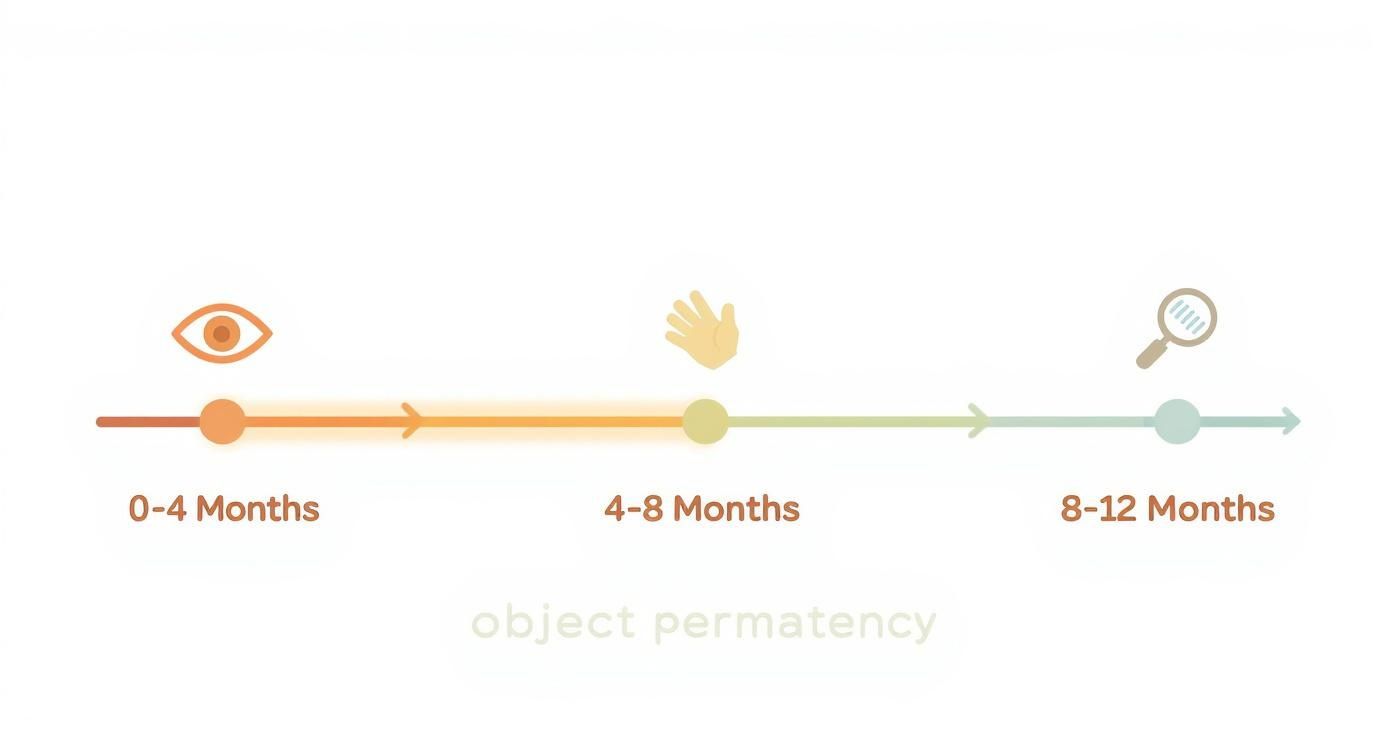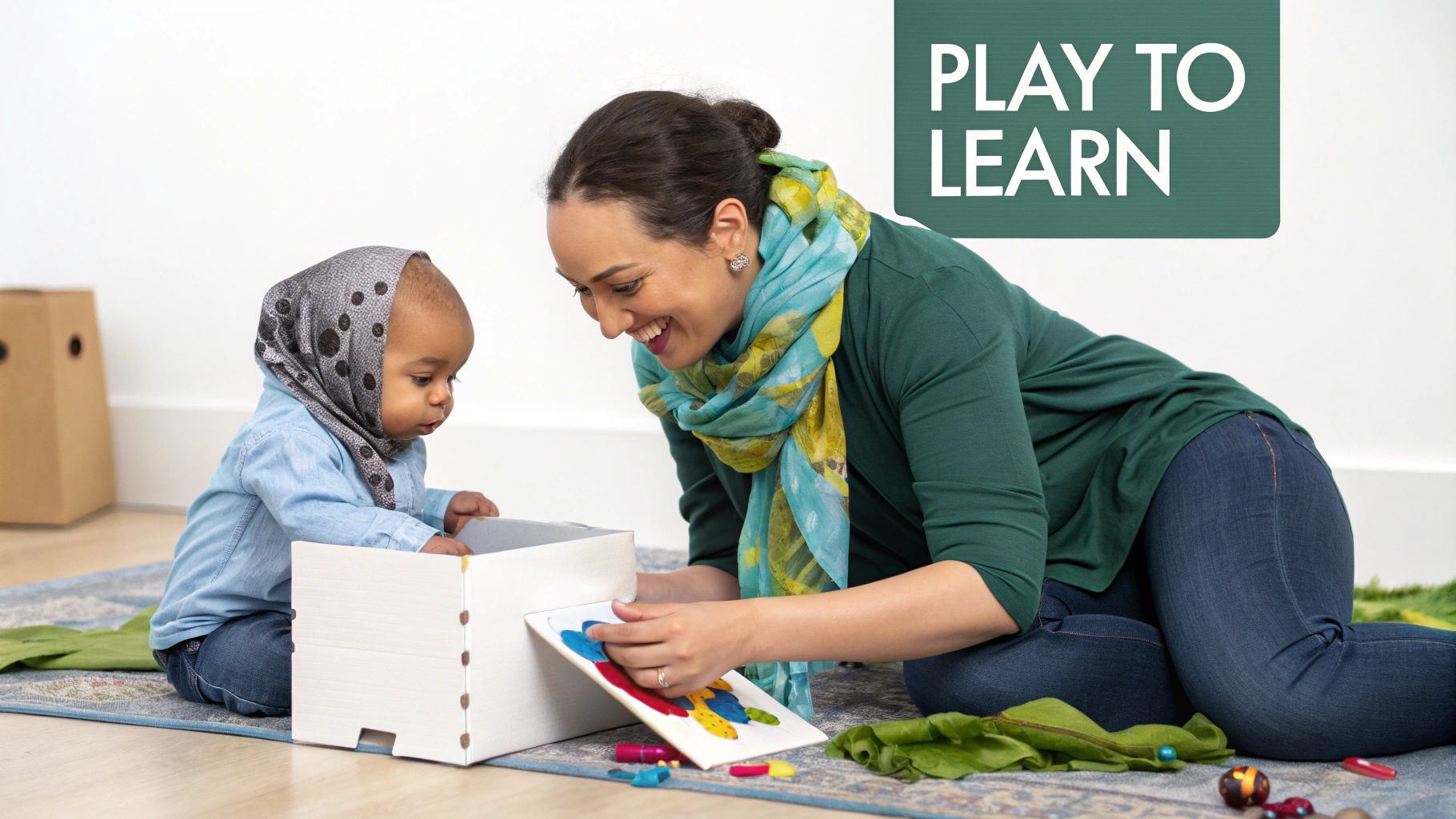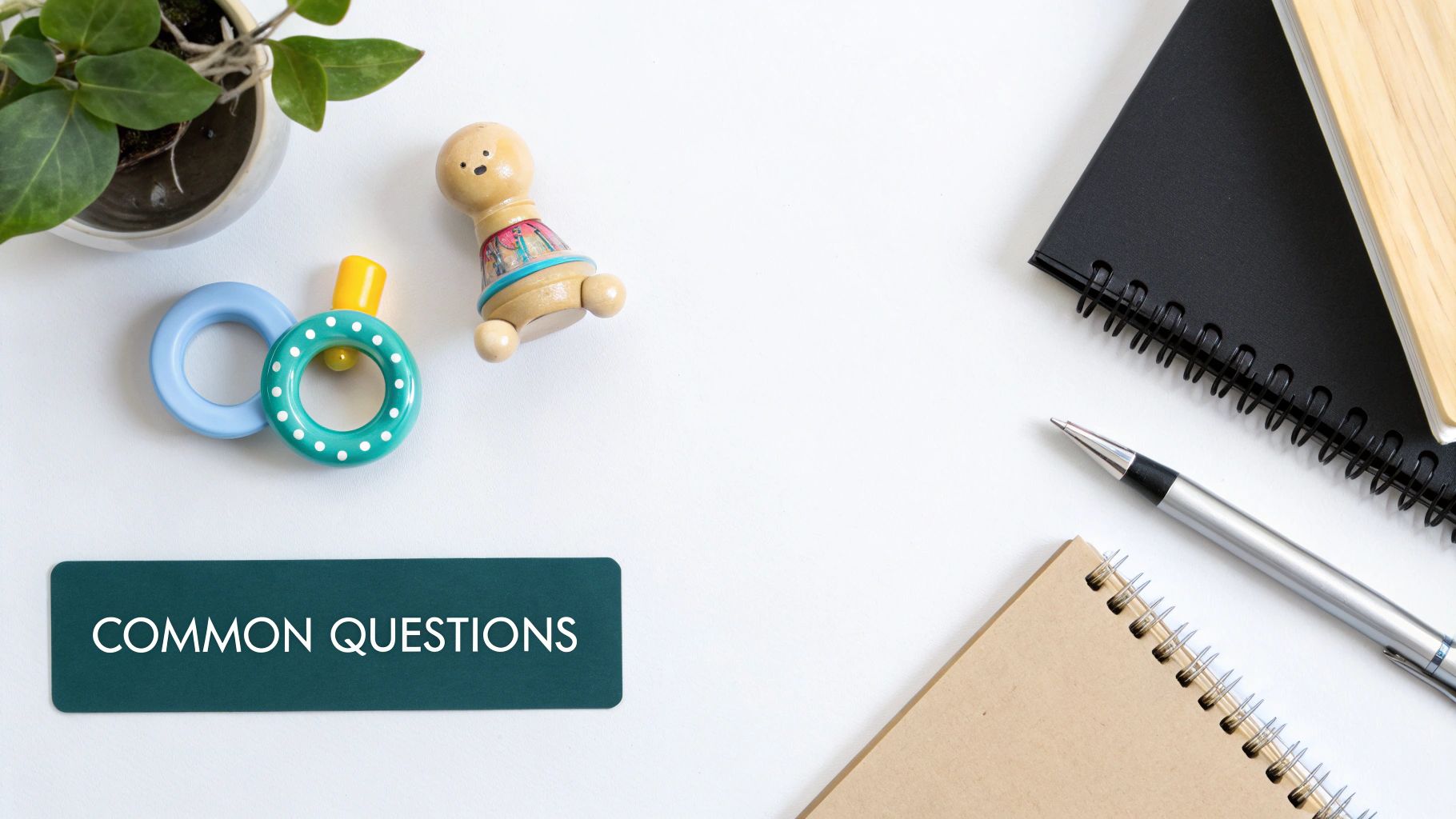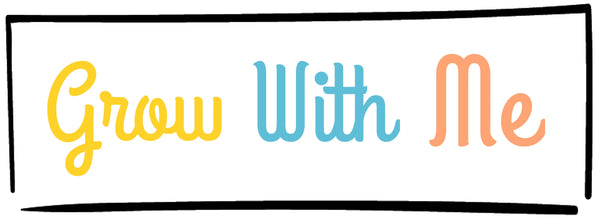
What Is Object Permanence in Your Baby's World?
Share
Ever wondered what's going on in your baby's head when you play peek-a-boo? That look of pure shock and delight isn't just an act—it’s a window into a massive cognitive leap they're making. They're learning about object permanence.
In simple terms, object permanence is the understanding that things stick around even when we can't see, hear, or touch them. For a baby, "out of sight" genuinely means "out of mind" until this skill clicks into place.
Understanding This Core Cognitive Leap
Think about your favourite mug. If you put it in a cupboard and shut the door, you know it's still there, waiting for your next cuppa. That certainty is object permanence in action. It's a fundamental concept that we take for granted, but for a baby, it's something they have to figure out from scratch.
It’s all about developing the mental ability to hold an image of something in their mind without it being right in front of them. This might sound straightforward, but it represents a monumental shift in how your little one sees the world.
Before mastering this, a baby's reality is based purely on what's happening in the moment. When you hide a colourful rattle under a blanket, it doesn’t just disappear from view; for them, it has literally stopped existing. This is why peek-a-boo is so magical—your reappearance is a genuine, wonderful surprise every single time.
The Foundation for Future Learning
Grasping that the world is consistent and predictable is the bedrock for so many other developmental milestones. It’s not just about finding hidden toys; it's the first step towards much bigger things:
- Developing Memory: Remembering a toy is under a blanket helps strengthen the neural pathways needed for both short-term and long-term memory.
- Problem-Solving Skills: The simple act of searching for a hidden object is one of your baby’s first real-world problems to solve, sparking curiosity and persistence.
- Symbolic Thought: This skill lays the groundwork for more complex thinking, like pretend play where one object can stand in for another. You can learn more about this in our article on what is symbolic play.
When Does It Typically Develop?
So, when does this lightbulb moment happen? Object permanence is a huge milestone, and developmental studies show that UK infants typically start showing signs between 4 and 12 months of age.
It doesn’t happen overnight. At first, a young baby won’t even try to look for a hidden toy. A little later, they might start looking for partially hidden items, and eventually, they’ll actively search for things that are completely out of sight.
Key Takeaway: Object permanence is your baby’s realisation that their world is stable and predictable. It’s the understanding that people and objects exist independently of them, even when they're not looking.
To make this even clearer, here's a quick summary of the key ideas.
Object Permanence at a Glance
This table breaks down the core concept into simple, bite-sized pieces.
| Concept | Simple Explanation | Typical Age Range (UK) |
|---|---|---|
| Object Permanence | Knowing something is still there even when you can't see it. | 4–12 months |
| "Out of Sight..." | For a baby, it's "...out of mind." Hiding a toy makes it vanish. | 0–4 months |
| Early Signs | Baby starts looking for partially hidden objects. | 4–8 months |
| Full Understanding | Baby actively searches for completely hidden objects. | 8–12 months |
Essentially, this journey is about your baby building a mental map of the world, one that includes all the things they can't currently see.
Mapping Your Baby's Developmental Journey
Object permanence doesn't just switch on one day. It’s a fascinating, gradual unfolding of understanding that happens in distinct stages. Watching this progression helps you realise the incredible cognitive work your baby is doing, turning simple playtime into a series of milestone celebrations.
Think of it like a little detective learning their craft. At first, they only see what's directly in front of them. Soon enough, though, they start following clues and searching for what’s hidden.
The timeline below breaks down the key phases of this developmental leap, from simply watching an object disappear to actively hunting for it.

This visual guide shows just how much your baby’s interaction with the world changes, shifting from passive observation to purposeful action over their first year.
The First Glimmers (0-4 Months)
In the very beginning, your baby’s world is a constant stream of "now you see it, now you don't." If their favourite soft rattle drops out of their line of sight, it has, for all intents and purposes, vanished from existence.
You won't see them looking for it because, in their reality, there's nothing to look for. Their understanding is completely tied to what their senses can perceive in that exact moment. This is the baseline from which all their future problem-solving skills will grow.
Partial Understanding (4-8 Months)
Around the four-month mark is when things start to get really interesting. Your baby will begin to follow objects with their eyes and might even reach for something that is only partially hidden.
For instance, if you hide their teddy bear under a blanket but leave a foot peeking out, they might pull at the blanket to reveal the rest. They're starting to connect the dots, realising that a small, visible part can represent the whole.
This stage is a critical bridge. Your baby is beginning to suspect that objects have a life of their own, even when partially obscured, setting the stage for more complex searching.
Simple games are perfect for supporting this emerging skill. Our guide on activities for a 6-month-old is packed with fun, play-based ideas.
Active Searching (8-12+ Months)
This is the phase where your baby truly becomes a little explorer. By now, they understand that a completely hidden object still exists and will actively search for it. Hiding a toy under a cup doesn't fool them anymore; they'll lift the cup to find their prize.
However, mastery is still a work in progress. They might struggle with more complex hiding games, like moving an object from one hiding spot to another while they watch. This is perfectly normal! They are still building the working memory and cognitive flexibility needed for these multi-step challenges.
This period marks the true beginning of what we recognise as object permanence, laying the groundwork for more advanced problem-solving later on.
Object Permanence Milestones by Age
To give you a clearer picture, here’s a breakdown of the typical journey. Remember, every child develops at their own pace, so think of these as guideposts, not deadlines.
| Age Range | Observed Behaviours and Skills | What This Means |
|---|---|---|
| 0-4 Months | Looks at objects but doesn't search when they are hidden. May show brief surprise or confusion when something disappears. | Out of sight is literally out of mind. Reality is based purely on what they can see, hear, or touch right now. |
| 4-8 Months | Follows objects as they disappear. Will reach for a toy that is only partially hidden. Begins to enjoy simple peek-a-boo games. | The first seeds of object permanence are sprouting. They suspect things exist even when they can't see the whole item. |
| 8-12 Months | Actively searches for a fully hidden object. Can find a toy hidden under a single blanket or cup. | They have a solid grasp of basic object permanence. They know hidden things are still there and are motivated to find them. |
| 12-18 Months | Can find an object hidden under one of two or three cloths. Watches you hide something and remembers its location. | Their working memory is improving. They can now hold the location of a hidden object in their mind for longer. |
| 18-24 Months | Can solve more complex hiding puzzles, like finding an object moved between multiple hiding spots. Begins to use mental representation. | This is advanced object permanence. They can imagine the object's journey and search logically, marking a huge cognitive leap. |
Watching these skills unfold is one of the most rewarding parts of parenting. Each new discovery, from pulling away a blanket to solving a multi-step hiding game, is a testament to their growing mind.
Why This Milestone Is a Cognitive Game Changer
Mastering object permanence is about so much more than just winning at peek-a-boo. This single cognitive leap is a fundamental building block for your baby’s future learning, emotional development, and even their ability to think in complex ways. It's the moment their world shifts from a series of fleeting, disconnected moments to a stable, predictable place.
When your baby searches for a hidden ball, they aren’t just playing; they are actively exercising their brain. This simple act of remembering that the ball still exists strengthens the very architecture of their memory. Think of it as a workout for their developing mind, building the pathways needed for short-term recall and, eventually, long-term memories of people, places, and experiences.
The Link Between Memory and Understanding
This connection between memory and understanding is incredibly powerful. For instance, UK-based research showed that 14-month-old infants could remember where an object was hidden even after a full 24-hour delay. In the study, an impressive 85% of infants correctly found the hidden toy, highlighting just how robust their early memory can be once object permanence is in place.
This ability to hold a mental image of something they can’t see is the very first step toward symbolic thought. It’s the same skill they’ll later use to understand that the word "cup" represents their actual sippy cup, or that a wooden block can stand in for a car during pretend play.
In essence, object permanence gives your child their first mental toolkit. It allows them to think about things that aren't right in front of them, paving the way for imagination, problem-solving, and language.
Emotional Growth and Secure Attachments
Beyond memory and logic, this milestone has a huge impact on your baby's emotional world. One of the classic signs that object permanence has arrived is the start of separation anxiety. Suddenly, your baby understands that you still exist even when you leave the room, and they might protest because they want you back!
While this phase can be tough for parents, it’s actually a brilliant sign of their growing attachment to you. Understanding that you haven't vanished is the first step toward building trust and security. They are learning a crucial life lesson: separations are temporary. This realisation is key to developing resilience and managing big feelings. There are many gentle ways to navigate this period and support your little one when they’re struggling with separation anxiety in infants.
Ultimately, grasping object permanence helps your baby build a secure foundation for life. It teaches them that their world, and the people in it, are reliable. This cognitive game-changer isn't just about objects; it's about building a predictable and safe world inside their own mind.
Playful Ways to Nurture Object Permanence
The great news is that helping your baby understand object permanence doesn't involve any special equipment or formal lessons. This huge cognitive leap is built right into the simple, joyful games you play together every day. By turning these little interactions into gentle learning moments, you're strengthening the vital connections firing away in their brain.

The goal is never to test them but to create a fun, predictable world where they can figure things out at their own pace. Every game you play reinforces the idea that their world is a stable, trustworthy, and wonderful place to be.
Classic Games with a Purpose
Some of the best activities are the ones parents and carers have been playing for generations. There’s a reason they’ve stood the test of time—they tap directly into that core concept of "now you see it, now you don't."
-
Peek-a-Boo: This is the quintessential object permanence game! When you hide your face and then reappear with a big smile, you're showing them that you still exist even when they can't see you. It's a profound lesson wrapped up in a simple, giggly game.
-
Hiding Toys: Start small. Partially cover a favourite toy with a light silk scarf or a piece of muslin and see if they pull it off. As they get the hang of it, you can hide it completely. This simple act encourages them to be active little detectives.
-
Lift-the-Flap Books: Board books with sturdy flaps are fantastic for this skill. Every flap they lift reveals a hidden picture, proving again and again that things are still there even when they’re covered up.
All these activities are rooted in the principles of play-based learning, where children learn best simply by exploring and having fun.
Everyday Play Opportunities
You don't need to carve out special time for "object permanence practice." These learning moments can be woven right into your daily routine using things you already have around the house.
For example, dropping wooden blocks into a box one by one is a perfect game. As your baby drops a block in, you can say, "Bye-bye block!" and when you tip them all out again, exclaim, "Hello blocks!" This adds a fun verbal cue to the visual lesson of disappearing and reappearing.
Parenting Tip: Always keep it light and encouraging. If your baby gets frustrated looking for a hidden toy, help them out or make it easier next time. The aim is to build their confidence and curiosity, not cause any stress.
Using Play Kits to Support Development
Thoughtfully designed play kits, like our Grow With Me boxes, often include toys that are perfect for exploring this concept. Things like nesting cups, pop-up pals, or a ball and cup set are chosen specifically because they support this exact developmental stage.
- Nesting Cups: Hiding a small, safe object under one of the cups invites your baby to lift it and discover the surprise inside.
- Pop-Up Toys: These are brilliant because they teach cause-and-effect right alongside object permanence. The character disappears and then—boing!—pops back up, creating a delightful and predictable surprise.
These games don't just build an understanding of what is object permanence; they also give their fine motor skills and problem-solving abilities a real boost. Many of these activities are also fantastic sensory experiences. For more inspiration, have a look at our guide to sensory play ideas for babies.
Ultimately, the key is lots of repetition and positive reinforcement. Remember to celebrate every little discovery they make
When to Trust the Process and When to Ask for Help
It's completely natural to watch your baby's development like a hawk. We all do it! But it’s important to remember that those milestone charts are just guides, not strict deadlines. Every single baby has their own unique timeline for figuring out big concepts like object permanence, and they all get there at their own pace.
So, if your little one doesn't immediately lunge for a toy you've just hidden, it’s almost certainly not a cause for panic. They might just be tired, distracted by a fascinating speck of dust, or simply not in the mood for that particular game right now. There's a huge spectrum of what's considered "normal" development, and trusting this natural unfolding is often the best thing you can do.
Knowing When to Check In
That said, it’s always smart to be observant. While a bit of variation is the norm, it might be worth having a chat with your health visitor or a paediatrician if you notice a consistent pattern over time.
Think about reaching out if you see the following:
- No Interest in Hide-and-Seek Games: By 12 months, your baby consistently shows zero interest in interactive games like peek-a-boo or trying to find a partially hidden toy.
- Doesn't Look for Dropped Items: Around their first birthday, they still make no attempt to look for an object after it's been dropped or completely hidden from view.
A Quick Reassurance: Seeing these signs isn't a reason to worry, but rather a gentle nudge to get a second opinion. An early conversation can give you valuable peace of mind and make sure your baby is getting all the right support for their developmental journey.
Your Questions About Object Permanence, Answered
Even with a roadmap of the developmental timeline, it's natural to have more questions pop up. It’s one of the most fascinating leaps in your baby’s understanding of the world, after all. Let's dig into some of the most common things parents wonder about.

So, Is Peek-a-Boo Really That Important?
In a word: yes! It might feel like just a silly game, but peek-a-boo is a powerhouse for teaching object permanence. Every single time your face vanishes behind your hands and then magically reappears, you’re sending a powerful message to your baby’s developing brain: things (and people!) still exist even when I can’t see them.
This simple, back-and-forth game is one of the most natural and joyful ways to help your baby make this huge cognitive leap.
How Does This Connect to Separation Anxiety?
The two are completely intertwined. It’s no coincidence that separation anxiety often kicks in right around the time your baby starts grasping object permanence. Suddenly, they understand that when you leave the room, you haven't just disappeared into thin air—you're somewhere else without them.
The problem is, they don't have a concept of time or the unshakeable certainty that you're coming back. This new knowledge is what fuels their distress.
As their understanding grows stronger, so does their confidence that your leaving is only temporary. This is a perfect example of how a cognitive milestone has a direct and powerful impact on他们的 emotional world.
My Baby Gets Upset When I Hide a Toy. Should I Stop?
A little bit of frustration isn’t necessarily a bad thing. In fact, it often shows that your baby is really engaged and working hard to figure out the puzzle you've set for them. But the golden rule of playtime is that it should be fun and connecting, not stressful.
If your baby’s frustration boils over into genuine distress, that’s your cue to make the game a bit easier. You could try:
- Hiding the toy partially: Let a little bit stick out so they have a clear clue to follow.
- Using a thinner cloth: A translucent scarf feels less final than a thick, heavy blanket.
- Cheering them on: Celebrate every effort, not just the successful find!
Always tune into your baby's signals and keep things light and positive. Building their confidence is just as important as building any new skill.
At Grow With Me, our play kits are thoughtfully designed to meet your child exactly where they are. We include toys that make learning about big concepts like object permanence feel like pure, joyful play.
